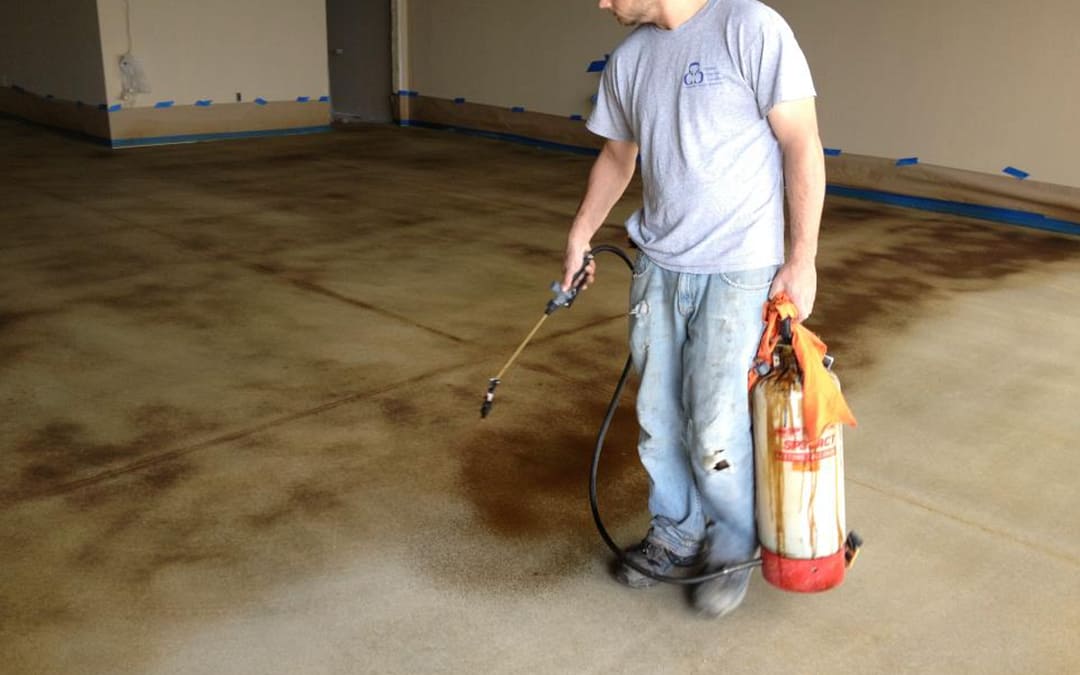The key to effectively dying concrete is prepping the surface with cleaning tools, etching agents, and then sealing the dye after application to protect the quality of the color. Concrete dye can completely change the tone of a space.
Eliciting warm or cool colors can have varying influences on employee productivity, for example, and guests will appreciate a branded commercial space. Of course, many modern residential areas currently utilize finished concrete floors as an alternative to floor tiling or hardwood, and these too can benefit from a quality dye job.
This post will cover the basics for effectively dying a concrete floor.
Test the Concrete for Compatibility
Finished concrete will not take well to your concrete dye. So you’ll need to test the concrete for its readiness to receive the dye. You can do this by implementing a drop test. Take a little water and leave a few droplets across the concrete surface.
When you see beaded-up water that stays on the surface, that means the concrete has sealer and will not bond well with the dye. If, however, the water soaks into the concrete over time and darkens, then it should be ready to absorb and effectively take in the colors of your dye.
Cover Walls and Any Furniture or Machinery You Want to Protect
As you may know, dyes have a way of getting places – especially places you’d rather avoid staining. Be sure you cover up walls and items you’re unable to move out of the area (you can use plastic sheets and tape or whatever is convenient). If you end up using a sprayer to apply your dye, you’ll be glad you did.
Sweep, Mop, & Etch Your Floor
Sweep up dirt and debris with a good broom, preferably one that can cover a lot of ground. Depending on your operation and whether there are excess oils or chemicals on the surface, you may want to use some heavy-duty cleaner to remove stubborn spots.
- Oils and chemicals can be removed using concrete etching agents. This will also better prep the concrete pores for absorbing the dye’s colors. Commercial garages or machine shops are more likely to need this extra step.
Otherwise, go ahead and start scrubbing with a damp mop. But make sure you let it completely dry before you move onto the dying phase.
Apply the Concrete Dye
Use a sprayer for an effective coat of dye. This will deliver a consistent spray and all-around safer application than a paint roller or other alternative.
Before getting too far in, ensure the dye comes out consistently without drips falling from the wand, this will help you prevent an inconsistent coat.
Once you’ve got a clean spray, go ahead and apply the dye in a circular or figure eight motion. This will help build up the color evenly. Try to keep the wand about a foot from the surface as you spray.
How Many Coats of Dye Should I Apply to My Concrete?
Apply at least two coats of dye to your concrete, waiting two hours between coats if the room is ventilated or longer if necessary. We recommend three coats as a safe bet.
Seal the Surface
Once dry, use a dust mop to clean the newly dyed surface and then seal the concrete immediately. You can also use a sprayer for sealing. Adding two coats of sealer will ensure the protection of your surface against UV rays, scratches and scuffs, corrosion, and stains.
Should I Stain or Dye a Concrete Floor?
To a novice or a homeowner, it may be difficult to tell the difference between concrete dyes and stains. Dyes can provide a deeper color saturation, while stains are more resistant to UV rays. In other words, interior spaces—especially those that rely on the color spectrum for interior design purposes—may want to choose dyes. Though there aren’t issues with staining interior concrete if that’s your preference.
If the surface has a lot of exposure to the sun, then your best bet is to use concrete stain. Of course, a quality sealer can also help with UV resistance.
Concrete Dyes, Sealers, & Surface Equipment from Runyon
Runyon Surface Prep is a one-stop shop for preparing and finishing concrete surfaces. We offer dyes, stains, sealers, and a wide range of pigments. We also have an extensive catalog of equipment that ranges from everyday accessories to concrete floor grinders, ride-on power trowels, and much more.
